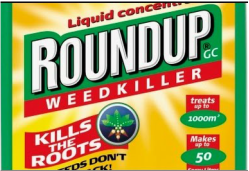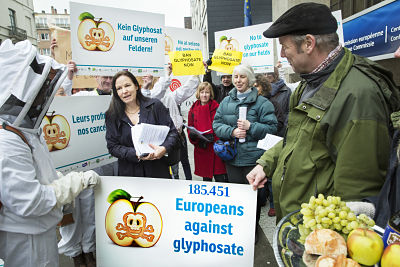| No time to read? Watch my v-log with Prof. Jane Stout of Trinity College Dublin on bees, neonicotinoids, glyphosate and what we can do to help protect Ireland's pollinators filmed at Bloom in the Park garden festival in Dublin's Phoenix Park (4min run-time). | |
“Float Like a Butterfly, Sting Like a Bee” – Why nature works better than RoundUp.

When glyphosate was officially authorised in the E.U. in 2002, the evidence used in the approval process relied entirely on studies funded by the pesticides industry, many which were unpublished. The 2002 E.U. approval process also only considered studies on glyphosate alone without the full spectrum of chemicals in RoundUp, which some studies indicate may increase the toxicity of glyphosate.
Furthermore, the 2002 approval process for glyphosate failed to consider whether the herbicide could disrupt human hormone and reproductive systems. In parts of South America, rates of birth defect and miscarriage have increased in areas where pregnant women live close to fields sprayed with glyphosate. When this piece was published in the Irish Examiner, that sentence elicited a strong response, with some on Twitter calling it a "gish gallop" and accusing me of "ignoring the literature". As a scientist, I take pride in being able to support claims with scientific peer-reviewed evidence, so it was with extreme caution and discussion with the Editor that I included that statement in my OpEd. Unfortunately, a 750 word limit doesn't give you the opportunity to demonstrate the consideration that goes in to every sentence. To address those unfounded accusations, here's a brief peer-reviewed evidence base:
- A study in Paraguay: babies of women living within one kilometre of fields sprayed with glyphosate were more than twice as likely to have birth defects (Benítez-Leite et al., 2009 Archivos de Pediatría del Uruguay Vol 80 pp 237-247).
- Lab-based studies have shown malformations in frog and chicken embryos exposed to glyphosate-based herbicides (Paganelli A et al, 2010 Chemical Research in Toxicology Vol 23 pp 1586-1595)
- Glyphosate and AMPA have both been shown to be “genotoxic” – that is they interfere with a cell’s ability to accurately copy DNA and reproduce, leading to potential genetic mutations and an increased risk of cancer (Hoeijmakers, 2001 Nature Vol 411 pp 366-374).
- In Ecuador and Colombia, where glyphosate herbicides have been used to control cocaine production, studies have found genetic damage and increased rates of miscarriage during the spraying period (Paz-y-Mino et al., 2007 Genetics and Molecular Biology Vol 30 pp 456-460 and Bolognesi et al. 2009 Journal of Toxicology and Environmental Health, Part A Vol 72 pp 986-997) and in the soy-growing Chaco district of Argentina where glyphosate is used, cancer rates have increased fourfold in the last decade (López SL et al. 2012 Advances in Molecular Toxicology Vol. 6 pp. 41-75)
| Non-governmental organisations have fought hard to prevent further application of glyphosate, arguing the EU should uphold the precautionary principle to avoid further public risk until scientific evidence is evaluated. In contrast, the agricultural lobby sees glyphosate as “vital” for crop protection and argues banning glyphosate will catalyse outlawing hundreds of other “vital” agricultural chemicals. |
Do we really need glyphosate for “safe, secure and affordable” food? The World Health Organisation declared glyphosate a ‘probable carcinogen’ last year, and there’s no doubt glyphosate negatively impacts farmland biodiversity, water quality and food supplies for birds and insects. Glyphosate can hardly be categorised as “safe”.
One could argue in the short term glyphosate could make our food supply more available by making farmers’ work easier and possibly increasing crop yields. However, in the long-term, continued use of such chemicals is more likely to decrease our food safety and security rather than improve it.
Ultimately, food security is dependent on nature. When chemicals like glyphosate kill the food supply of birds and insects, they contribute to the death of wildlife we need to pollinate our crops, fertilise our soils or control pests naturally.
We’ve already seen how agricultural chemicals can damage nature with the collapse of honeybee populations as a result of neonicotinoid pesticides in the EU or with the historic ‘Silent Spring’ detailed by Rachel Carson in the 1970s after DDT was implicated in thinning eggshells in bird populations across the U.S.A.
Both neonicotinoids and DDT are banned as a result of their devastating impacts on nature, but these chemicals persist and accumulate in flora and fauna and even in our bodies. Despite a U.S. ban 40 years ago, DDT continues to be found in American produce and has been measured in the blood of 99% of Americans tested. DDT is still implicated as a cause of cancer, infertility, and other health effects among the U.S. population.
Glyphosate appears no less endemic. A 2015 study carried out by University of California San Francisco found glyphosate in the urine of 93% of Americans tested, and a 2013 study in Europe found traces of glyphosate in the urine of individuals from all 18 countries tested.
The more glyphosate is applied, the more weeds become resistant and the more application is required to achieve the same effect. In an effort to combat these “super weeds”, we expose our environment and our bodies to more of this chemical.
The farming lobby argues glyphosate improves soil structure, but it also damages soil chemistry by affecting the biological and chemical processes around plant roots, including the ability to fix nitrogen, resulting in the need for increased fertilisers at additional environmental and economic cost.
In this battle between the agricultural industry and environmentalists, the argument has been falsely framed as a choice between “safe, secure and affordable food” versus protection of nature and environment. In reality, what environmentalists are fighting for is not nature at the expense of people’s food but “nature for people’s food”.
In the long term, what may make farmers’ jobs a little easier today will take such a toll on nature that their livelihoods, and our food security, will become more challenging in the decades to come. It is nature that creates the optimal conditions to grow food, not Monsanto.
| For more on glyphosate and how you can get involved, check out Friends of the Earth Europe's great work. Keep fighting the good fight! -Cara |



 RSS Feed
RSS Feed
